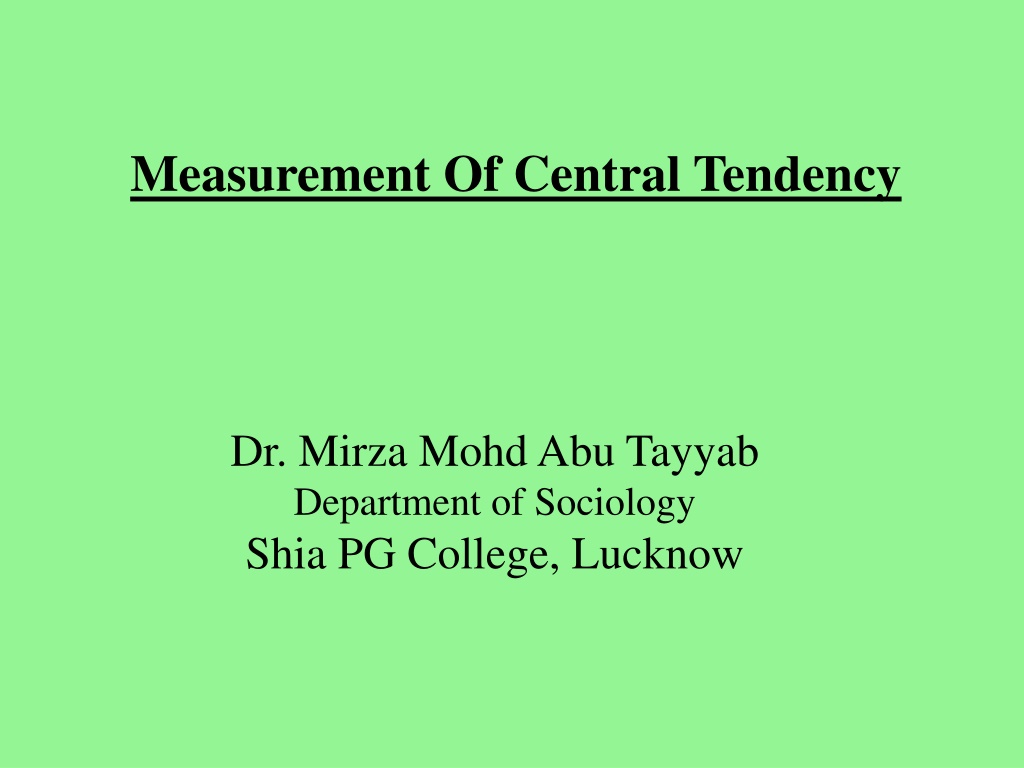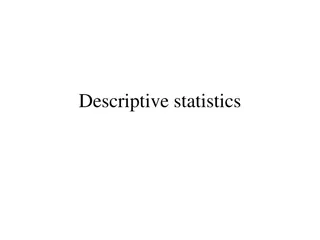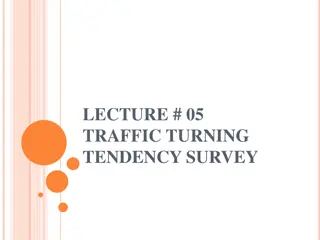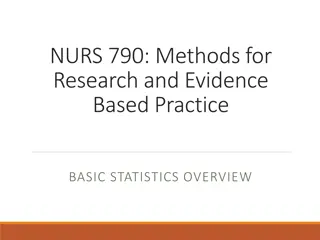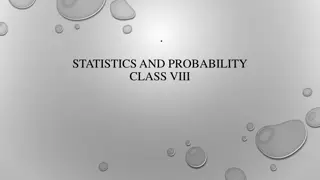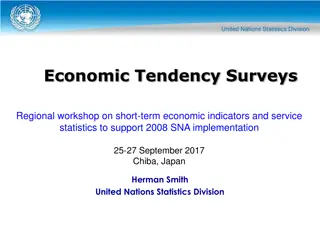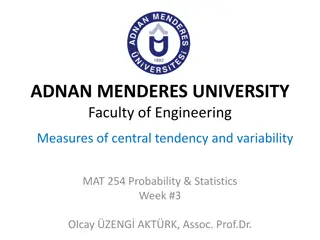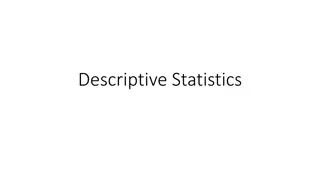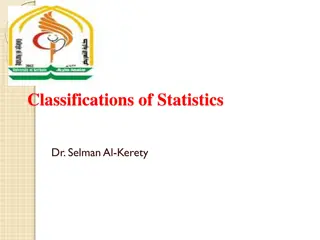Measurement of Central Tendency in Statistics
A central tendency is a key concept in statistics, representing a typical or central value in a distribution. This includes measures such as arithmetic mean, median, and mode for both population and sample data. Understanding central tendency is crucial for representing data concisely, making comparisons, and facilitating further statistical analysis through methods like mean calculation for both ungrouped and grouped data, as well as weighted mean and harmonic mean.
Download Presentation

Please find below an Image/Link to download the presentation.
The content on the website is provided AS IS for your information and personal use only. It may not be sold, licensed, or shared on other websites without obtaining consent from the author.If you encounter any issues during the download, it is possible that the publisher has removed the file from their server.
You are allowed to download the files provided on this website for personal or commercial use, subject to the condition that they are used lawfully. All files are the property of their respective owners.
The content on the website is provided AS IS for your information and personal use only. It may not be sold, licensed, or shared on other websites without obtaining consent from the author.
E N D
Presentation Transcript
Measurement Of Central Tendency Dr. Mirza Mohd Abu Tayyab Department of Sociology Shia PG College, Lucknow
Importance Of Central Tendency To find representative value To make more concise data To make comparisons Helpful in further statistical analysis
Introduction: In statistics, a central tendency is a central value or a typical value for a probability distribution. It is occasionally called an average or just the center of the distribution. The most common measures of central tendency are the arithmetic mean, the median and the mode. Measures of central tendency are defined for a population(large set of objects of a similar nature) and for a sample (portion of the elements of a population).
Mean The MEAN of a set of values or measurements is the sum of all the measurements divided by the number of measurements in the set. The mean is the most popular and widely used. It is sometimes called the arithmetic mean.
Mean for Ungrouped data If we get the mean of the sample, we call it the sample mean and it is denoted by (read x bar ). If we compute the mean of the population, we call it the parametric or population mean, denoted by (read mu ).
Arithmetic Mean Calculated Methods for grouped data: Direct Method : Short cut method : Step deviation Method :
Example Of A.M: A sample of five executives received the following bonus last year ($000): 14.0, 15.0, 17.0, 16.0, 15.0 Solution:
Weighted Mean Weighted mean is the mean of a set of values wherein each value or measurement has a different weight or degree of importance. The following is its formula: where x = measurement or value w = number of measurements = mean
Harmonic Mean Harmonic mean is quotient of number of the given values and sum of the reciprocals of the given values . For Ungrouped Data For grouped Data
Harmonic Mean Example Calculate the harmonic mean of the numbers: 13.2, 14.2, 14.8, 15.2 and 16.1 Solution: The harmonic mean is calculated as below: AS ? ? X 13.2 14.2 14.8 15.2 16.1 Total 0.0758 0.0704 0.0676 0.0658 0.0621 1 ?=0.3147
Example: Calculate the harmonic mean for the given below: Marks F 30-39 2 40-49 50-59 3 60-69 20 70-79 32 80-89 25 90-99 7 11 Marks x f Solution: Now We ll find H.M as: 30-39 40-49 50-59 60-69 70-79 80-89 90-99 Total 34.5 44.5 54.5 64.5 74.5 84.5 94.5 2 3 11 20 32 25 7 0.0580 0.0674 0.2018 0.3101 0.4295 0.2959 0.0741
Geometric Mean Geometric mean is a kind of average of a set of numbers that is different from the arithmetic average. The geometric mean is well defined only for sets of positive real numbers. This is calculated by multiplying all the numbers (call the number of numbers n), and taking the nth root of the total. A common example of where the geometric mean is the correct choice is when averaging growth rates. The geometric mean is NOT the arithmetic mean and it is NOT a simple average. Mathematical definition: The nth root of the product of n numbers.
Question 1: Find the geometric mean of the following values: 15, 12, 13, 19, 10 x Log x 15 12 13 19 10 Total 1.1761 1.0792 1.1139 1.2788 1.0000 5.648
Median The MEDIAN, denoted M, is the middle value of the sample when the data are ranked in order according to size. Connor has defined as The median is that value of the variable which divides the group into two equal parts, one part comprising of all values greater, and the other, all values less than median For Ungrouped data median is calculated as: For Grouped Data:
Mode The MODE, denoted Mo, is the value which occurs most frequently in a set of measurements or values. In other words, it is the most popular value in a given set. Croxton and Cowden : defined it as the mode of a distribution is the value at the point armed with the item tend to most heavily concentrated. It may be regarded as the most typical of a series of value
Example 2: In a crash test, 11 cars were tested to determine what impact speed was required to obtain minimal bumper damage. Find the mode of the speeds given in miles per hour below. 24, 15, 18, 20, 18, 22, 24, 26, 18, 26, 24 Solution: Ordering the data from least to greatest, we get: 15, 18, 18, 18, 20, 22, 24, 24, 24, 26, 26 Answer: Since both 18 and 24 occur three times, the modes are 18 and 24 miles per hour.
Find the modal class and the actual mode of the data set below Number 1 - 3 4 - 6 7 - 9 10 - 12 13 - 15 16 - 18 19 - 21 22 - 24 25 - 27 28 - 30 Frequency 7 6 4 2 2 8 1 2 3 2
Advantages of Mode : Mode is readily comprehensible and easily calculated It is the best representative of data It is not at all affected by extreme value. The value of mode can also be determined graphically. It is usually an actual value of an important part of the series.
Disadvantages of Mode : It is not based on all observations. It is not capable of further mathematical manipulation. Mode is affected to a great extent by sampling fluctuations. Choice of grouping has great influence on the value of mode.
Advantages of Median: Median can be calculated in all distributions. Median can be understood even by common people. Median can be ascertained even with the extreme items. It can be located graphically It is most useful dealing with qualitative data
Disadvantages of Median: It is not based on all the values. It is not capable of further mathematical treatment. It is affected fluctuation of sampling. In case of even no. of values it may not the value from the data.
Properties of mode It is used when you want to find the value which occurs most often. It is a quick approximation of the average. It is an inspection average. It is the most unreliable among the three measures of central tendency because its value is undefined in some observations.
Properties of Mean Mean can be calculated for any set of numerical data, so it always exists. A set of numerical data has one and only one mean. Mean is the most reliable measure of central tendency since it takes into account every item in the set of data. It is greatly affected by extreme or deviant values (outliers) It is used only if the data are interval or ratio.
Relations Between the Measures of Central Tendency In symmetrical distributions, the median and mean are equal For normal distributions, mean = median = mode In positively skewed distributions, the mean is greater than the median In negatively skewed distributions, the mean is smaller than the median
Conclusion A measure of central tendency is a measure that tells us where the middle of a bunch of data lies. Mean is the most common measure of central tendency. It is simply the sum of the numbers divided by the number of numbers in a set of data. This is also known as average. Median is the number present in the middle when the numbers in a set of data are arranged in ascending or descending order. If the number of numbers in a data set is even, then the median is the mean of the two middle numbers. Mode is the value that occurs most frequently in a set of data.
